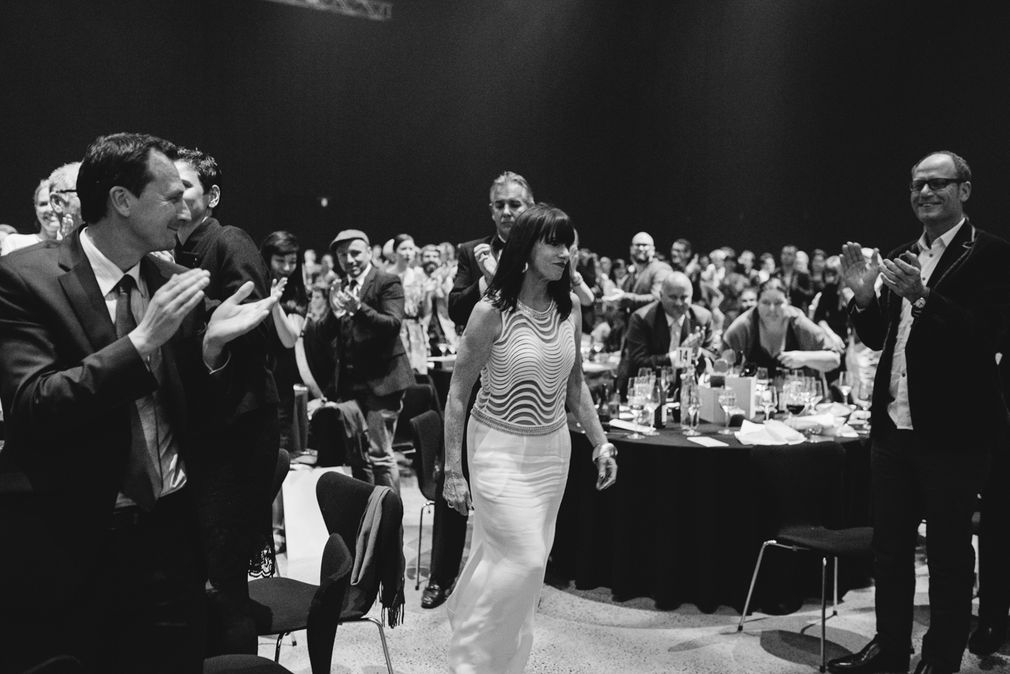In 2013, the Designers Institute of New Zealand honoured its Chief Executive, Cathy Veninga, with its highest award – a Black Pin for her outstanding “contribution of service and leadership to the institute.” As Tony Parker, a Fellow of the Institute, said at the awards presentation, Veninga is “totally dedicated to advancing the importance and contribution of the New Zealand design profession, to the value and quality of design professionals in our country and to the vitally important role design makes to our economic performance, cultural expression, national identity and sense of wellbeing.”
Like all Black Pin winners, Veninga has a long background in design leadership. She was first elected to the Institute’s Board in 1998, was its first female president – an important milestone with gender parity in design and architecture still under the microscope around the globe – and, in 2005, she was appointed as the first Chief Executive Officer of the Institute in 2005.
“At that time there were major global influences around design thinking and we needed to be responsive to this thinking as a professional body if we were to remain relevant,” she says. “Organisationally, and as a design community, we had to stop navel gazing and develop a more inclusive collaborative approach to the way we worked and engaged. The Institute, as a multidisciplinary organisation, gives us this rich and our unique point of difference.”
Veninga’s career in design could be considered synchronous with the growing sophistication of New Zealand’s growing design industries and cultures.
Up to 2005, the Designers Institute was an organisation that relied solely on the voluntary support, hard work and passion of its members. A full-time CEO provided some real operational structure to the organisation and allowed it to widen its ambitions while improving its ability to respond nimbly to challenges it faced.
Over the years, it began developing richer programmes that both inspired, educated and justified membership. The Designers Speak Series, says Veninga, has been especially successful in communicating the challenges designers face; “it talks about design process; it gets inside the stories”.
From the outset of her tenure, Veninga says her aim has been for the development of an inclusive organisation that encouraged the development of peer relationships through industry events. Importantly, the exponential growth of the Best Design Awards provided an annual benchmarking activity for the industry.
“The significance of the Best Design Awards is that has been crucial to raising standards in design while also providing a window of insight into what is actually happening in the design community. It is also an opportunity for those involved in design to get together with their clients and colleagues.”
Veninga cites the establishment of the Best Effect and Ngā Aho awards as important recent milestones. Best Effect qualifies the values of design to potential clients and might offer leverage in the argument that design has an important role to play in New Zealand’s economic future. Ngā Aho recognises New Zealand’s fortune in having strong indigenous culture and heritage to reference in its design expressions.
“The significance of the Best Design Awards is that has been crucial to raising standards in design while also providing a window of insight into what is actually happening in the design community.”
“Ngā Aho – that’s really important. I would say it is the most unique award of its kind in the world because of how it really values and appreciates how we are imbued with our own indigenous culture and how we are able to work collaboratively towards a co-design agenda.”
Just as the Best Design Awards can be seen as a means of benchmarking and standard-raising across the country, Veninga thinks the establishment of relationships with like-minded organisations in Australia and further afield can both raise design standards here and draw international attention to the quality of work here.
Veninga has formed strong partnerships with key Australian design organisations, such as AGDA (Australian Graphic Design Association) the DIA (Design Association of Australia), and the Australian International Design Awards, as well as reaching out to other international design organisations.
Networking with like-minded international design organisations has been a key component of Veninga’s time as CEO of the Designers Institute.
“Building these international relationships puts the spotlight on New Zealand design,” she says. “But the most important advocacy is to New Zealand’s central and local government, and to local businesses. It is important for us to produce case studies that demonstrate that design is a significant part of New Zealand’s economic future. Designers and their clients already achieve significant and measurable returns internationally. We just need government to signal more widely that New Zealand is an innovative country using great design.”
Veninga, who looks across New Zealand’s design landscape from an almost unrivalled position, believes New Zealand has a richness of community.
“It is important for us to produce case studies that demonstrate that design is a significant part of New Zealand’s economic future.”
“We are a diverse community operating across different design disciplines, but there is a recognition, I think, of the need and opportunity for collaboration. I think our communities are very responsive to global influences, especially around how design is implemented for clients. What the Institute is really about though, is building community, and while we try to deliver meaningful professional services as an organisation, we are really about facilitating the growth of the community and developing value for the community.”
Veninga was humbled to receive the Black Pin award – and also, perhaps, just a little angry that she was singled out for the unexpected honour. As many people in the design industries might agree – work can be its own reward. Veninga certainly enjoys hers. “I have the best job in the world as it offers diversity, vision and challenges. The challenges form part of the vision that creates the excitement.”
